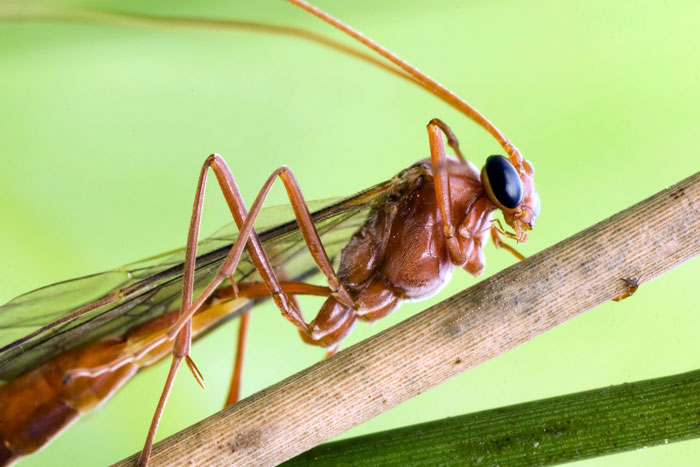
Copyright © Edwin Brosens All rights reserved.
Wasp (Ophion Impressus)
Sony Alpha 700 + Novoflex Bellow + Sigma 90/2.8 Macro + Flash + Tripod F/16 @ 0.4 sec.
“How many hours do you work?” “How do you find your subjects?” “How do you go about taking photos in the field?” Because I’ve repeatedly been asked a variety of questions about what it’s like being an insect photographer, I’ll take you with me from the moment I leave my bed until I return home in the evening.
5:00 a.m.: It’s still dark, but I need to be up and out the door and arrive at my location before the sun rises. As most photographers know, some of the best light for capturing most subjects is during those early morning hours.
In my camera bag is all the equipment required for macro photography: Sony Apha 700 body and a Tamron 90/2.8 macro in combination with a Novoflex bellows for large magnifications; Sigma 180/3.5 APO Macro lens, Sigma 20/1.8 EX/DG, and Sigma 10-20/4-5.6 wide-angle lenses for environment photos; two Sony flashguns, Sekonic L-608 Exposure meter, and a Manfrotto tripod-reflector.
6:00 a.m.: The sky is growing brighter as the sun is just beginning to break the horizon. One of my favorite nature reserves, Doode Bemde, with all of its insects, seems to be welcoming my arrival. I grab my backpack and tripod and start walking into the field in search of my first subject. It doesn’t take long before I find a Cranefly perched on the top of a flower and I’m certainly hoping it will be cooperative and stay in that position just a little longer. I hurry to set up my camera with a 20 mm lens onto the tripod and make all of the necessary adjustments needed to create a great environmental photo composition. All those little position, angle and focus changes can take up to 10 minutes as I repeatedly peer at that Cranefly through the viewfinder. Now I have only to wait for the sun to reach the desired point on the horizon.
Within five minutes the sun’s rays were cast perfectly on my subject, so I now have to be quick or I may miss this photo opportunity. I snap the shutter release button three times—just three times. Many people might protest, “Only three photos?” YES! I don’t have hours. I only have seconds before the light can change.
Seeing small insects through my viewfinder makes me as happy as a child. During these moments, my mind is focused on the insect. Everything else becomes invisible to me.
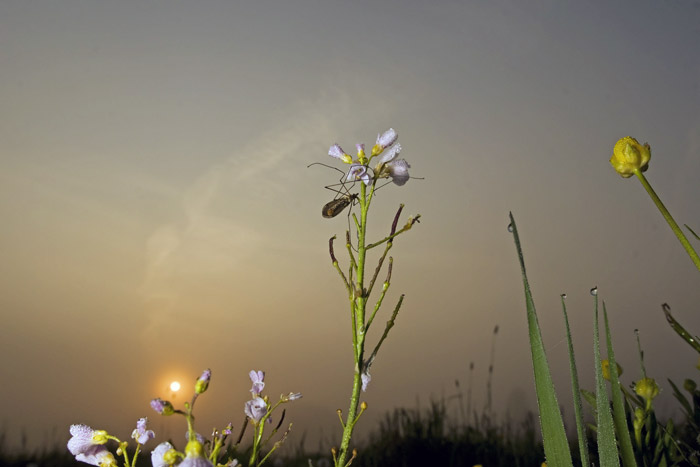
Copyright © Edwin Brosens All rights reserved.
Cranefly (Trichocera Relegationis)
The photo you see is here is the best of the three choices.
My Manfrotto tripod allows me to place my camera very close to the ground. It is used for stability, because early morning light requires long shutter speeds.
Sony alpha 700 + 20/1.8 lens + Flash F/16 @ 1/20 sec.
I gather up my gear and am off again in search of my next subject. I find a few flies, so I decided to add my Novoflex bellows and the 90/2.8 macro lens to the body of my camera so I can shoot a macro photo of the head of one of the flies. These types of images can be challenging with a bellows because of the amount of equipment used for the set up. The camera with its accessories is now a combined 20 cm (nearly 8 inches), and when I move the camera, the view in the viewfinder looks like passing racecars. With my camera setup placed onto my tripod, I move close to the insect’s eye—about 5 cm (approximately 2 inches) between the fly’s head and the front of my lens. I had a difficult time finding the right composition, but after a while I achieved success. Time is of the essence and these moments are critical, because if I make one wrong move, the fly will be off and away. I use my flash with a cable connection to get filled-in flash for the dark parts of the fly.
Patience is definitely required for these types of shoots, because you will encounter many instances where your subject will fly or move away and you’ll have to start over again, but the end results make it all worthwhile.
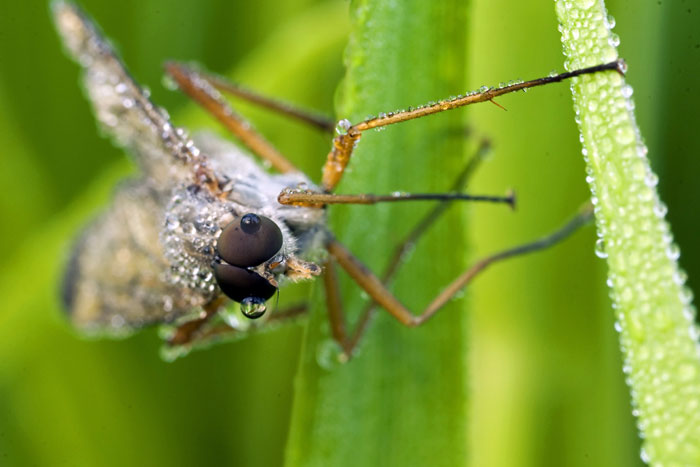
Copyright © Edwin Brosens All rights reserved.
Snipe Fly (Rhagio Scolopacea)
Sony alpha 700 + bellow + 90/2.8 macro lens + Flash F/16 @ 1 sec.
Later in the morning, I came upon a Parasitic Wasp taking nectar from the stamps on a flower. In order to capture this fast-moving subject, I’ll need to handhold the camera, so I set it up with my 180/3.5 mm macro lens. This lens also provides an opportunity to allow more distance between the insect and me. I’ve also added the flash on a Manfrotto 330 Macro Flash Bracket holder near the camera body in order to enhance the light on the subject.
FYI: The faceted eyes of insects are very sensitive. They may not see everything we can, but they are about ten times more sensitive than our eyes.
Looking through the viewfinder of my camera, I watch the wasp to study its behavior. I find myself questioning–what is it doing and why is it here in this place at this time? Is it more than just the quest for food? I’m inspired by the answers to such concerns, because insects are so interesting and important to humans.
Because capturing an insect’s behavior on a photo is an arduous challenge, I shot many photos–around thirty. During the first thirteen photos, I made a few mistakes and the wasp flew away, but luckily, he returned. His need for nectar far outweighed my intrusion on his territory.
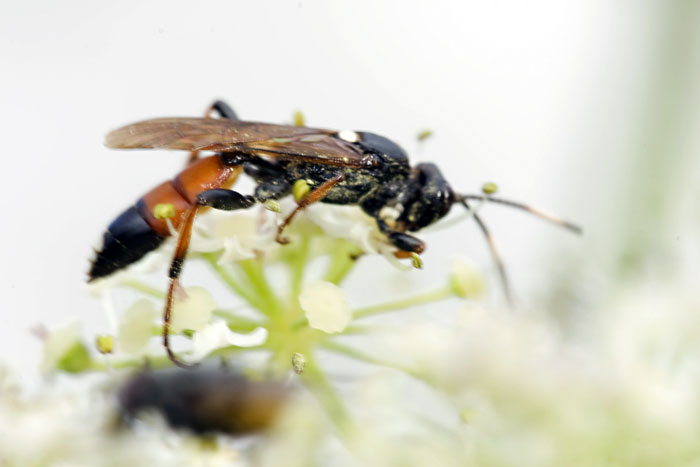
Copyright © Edwin Brosens All rights reserved.
Parasitic Wasp (Barichneumon bilunulatus)
I spent almost a full hour of shooting to catch a photo like this.
Sony alpha 700 + 180/3.5 APO Macro lens + Flash F/13 @ 1/160 sec.
11:00 a.m.: The morning has passed quickly and the sun is now too bright and creating too much high contrast to continue shooting, so I’ll take this opportunity to go back home and spend some time examining my images. I’m always asking myself questions like, “If I approach the subject differently or try a new technique, what would happen?” I work on ideas I’ve had and try to consider how my images can be approached from a fresh viewpoint. I’m always wondering how I could make them better–always looking for ways to improve my images.
The dawn of each new day brings with it a variety of challenges; the weather, the kind of natural light, and the types of insects that are available. So I get one subject in mind and try to find it in the field. If I can’t find it, it’s never wasted hours. I’ll just capture photos of other insects.
It’s important to visit the same place repeatedly to get a good understanding of the variety of insects you can expect to find in that location. Locality research may be time consuming, but it is well worth the effort. And once I’ve shot a particular kind of insect, I also do research to learn all I can about the insect itself. This added information helps me to develop another view of it and as such, helps me to capture and create better photos of it when I see it in the field again.
2:00 p.m.: Mid-day brings a softer light, so it’s time to return to the field. It doesn’t take long before I come upon some Hoverflies taking nectar from a thistle.
The sun is very bright in the background, so I have to overexpose my shutter speed by two to three stops. I also use my flashgun. New problems arise. Wind is making the plant move.
It took 90 minutes to get a good photo. Why? There were a variety of factors involved. I didn’t have a quality composition, although the exposure time was good, so I needed to reset what I saw through the viewfinder. Another shot revealed that my flash light was too “hard”. Yet another shot shows that my aperture setting is incorrect. And of course with the wind moving the thistle right at the moment I snapped the shutter button, another shot was lost. But with adjustments made and prevailing patience, I finally got what I wanted.
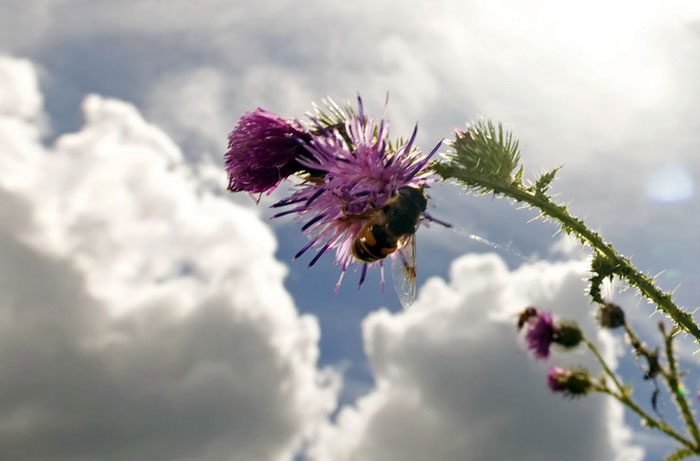
Copyright © Edwin Brosens All rights reserved.
Hoverfly (Syrphus Ribesii)
Sony alpha 700 + 20/1.8 lens + Flash F/14 @ 1/100 sec.
3:00 p.m.: I find a field wasp with a drop of water in his mouth. What a find—what a great shot this will be! I know I’ll have to be very careful setting up and shooting or he’ll fly away. I add my 180/3.5 APO macro lens to my camera body and my flashgun on the flash bracket before I slowly and quietly approach the wasp. Click ….click…click….he flies away irritated by me. He wasn’t pleased with my attention, but I was faster than he and got one good photo.
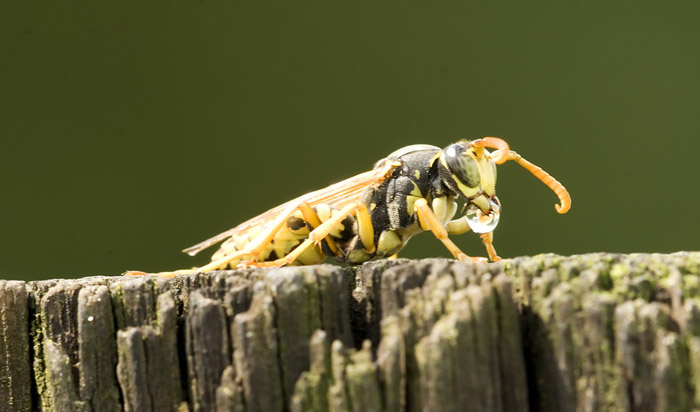
Copyright © Edwin Brosens All rights reserved.
Field Wasp (Polistes bischoffi)
Sony alpha 700 + 180/3.5 APO Macro lens + Flash F/14 @ 1/40 sec.
6:00 p.m.: I arrive home. During the evening, I spend time on the results of my day—more examination and evaluating of the photos. The weather has changed as has the lighting, so I wouldn’t be able to shoot good photos this evening. My day of photography has ended.
You can see by my experiences that getting a series of good photos is a process. What I have described is an overview of a day in August 2010. Although no two days of insect photography are identical, they often share similarities. They’re all challenging and engaging.
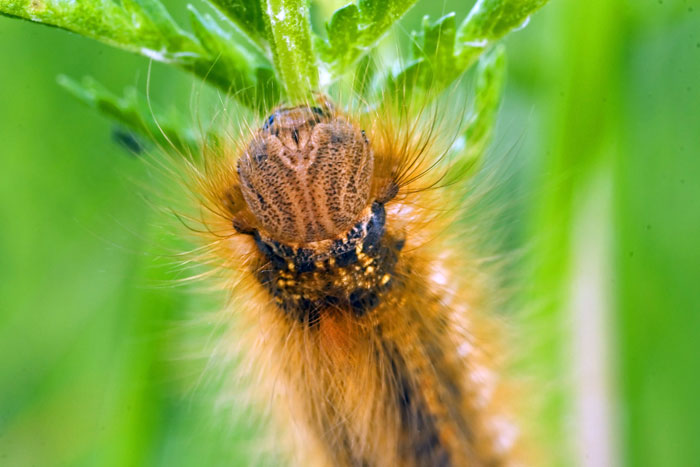
Copyright © Edwin Brosens All rights reserved.
Head Caterpillar (Philudoria Potatoria)
Sony alpha 700 + bellow + 90/2.8 macro lens + Flash F/14 @ 1/5 sec.
If you have been blessed with a patient nature and are infatuated by this earth’s smallest of creatures, then I encourage you to pick up your camera and macro accessories and get out in the field and try your hand at insect photography. The rewards are so very gratifying.
by Edwin Brosens

Leave a Reply